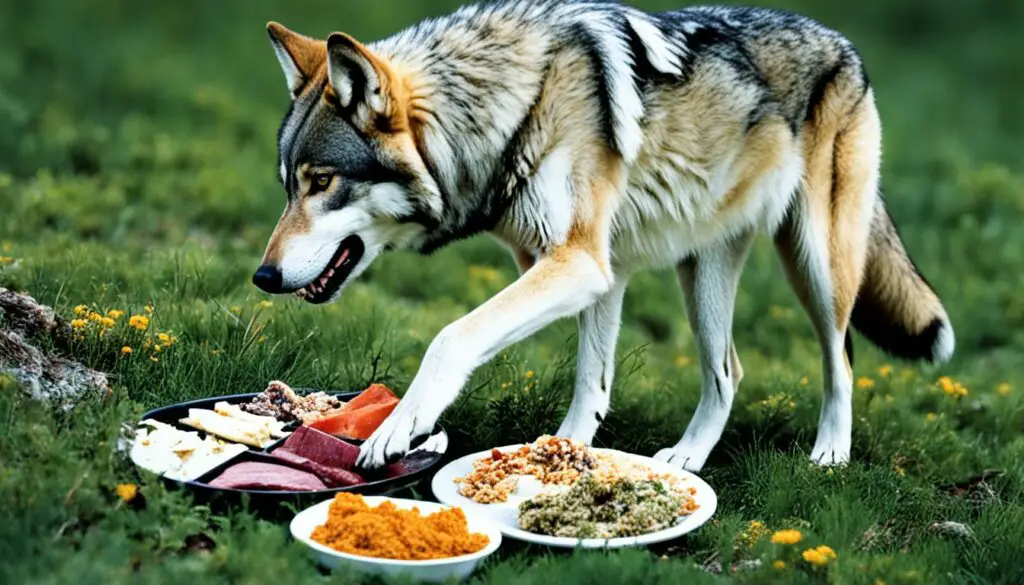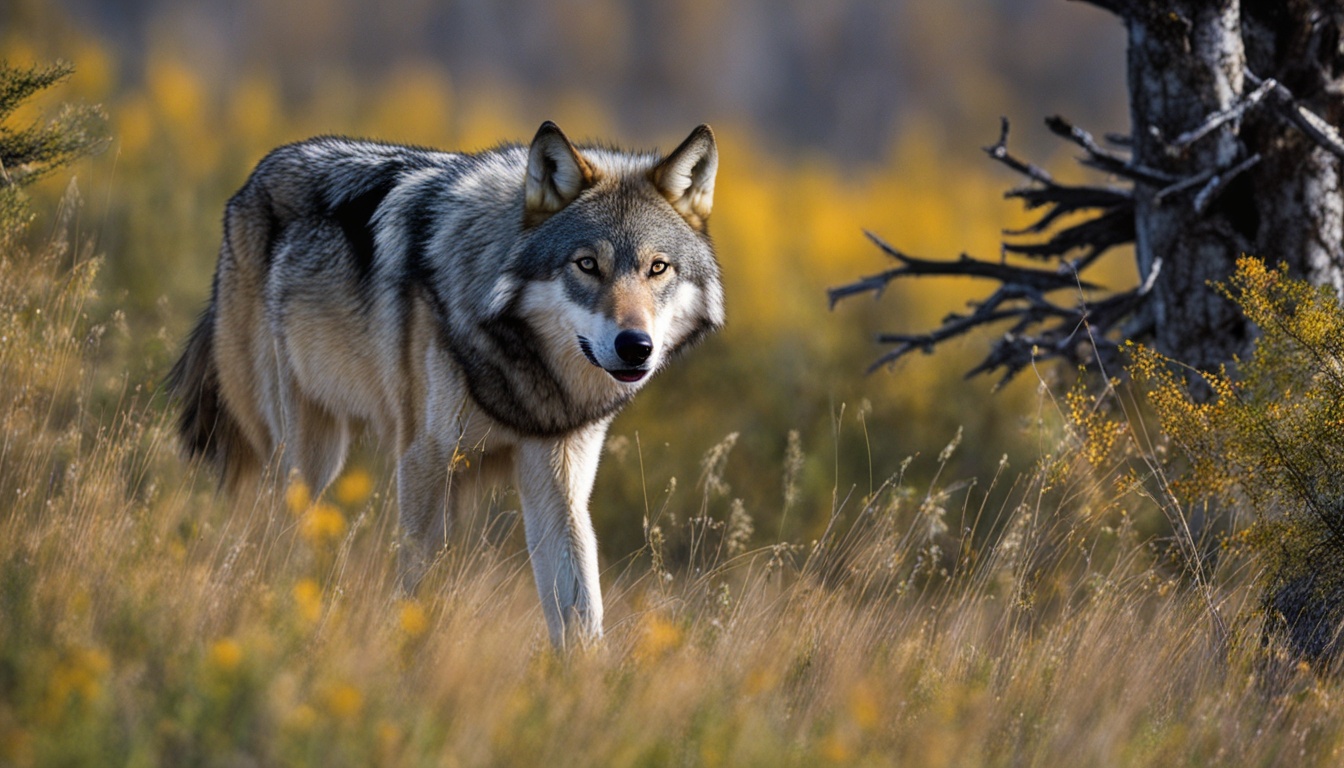Ever asked yourself, “What do gray wolves eat?” These animals play a key role in the American West’s ecosystems. But, they almost disappeared because of hunting. Thanks to strong conservation, their numbers have bounced back. Now, gray wolves live in places with enough food, few people, and nature that welcomes them.
Gray wolves love meat, with elk and deer being favorites. Yet, they’re smart and adaptable, sometimes snacking on plants and insects.
In wolf packs, what they eat is a team decision. They pick on the weaker elk and deer. This choice influences the health and number of those animals. It also shapes the whole area’s variety of life.
Get this: gray wolves need about four pounds of meat daily. Hunting together is how they get it. Their bond goes beyond just food; losing a pack member is a big deal, showing how important social life is for them.
Gray Wolf Feeding Habits
Gray wolves have complex feeding habits due to how they live and hunt. They are adaptable, using different hunting ways and working together in packs to eat. This allows them to get the food they need efficiently.
Hunting Techniques
Wolves are experts at hunting. They are “coursing carnivores,” which means they chase prey over big distances. Their hunting grounds can be 50 square miles. Each day they can travel up to 30 miles, sometimes reaching speeds of 40 mph in short bursts. Their ability to chase shows their great endurance and smart hunting tactics.
Pack Hunting Strategies
Pack hunting is key for wolves. Hunting together, they can catch larger animals. Then, this lets them feed as a group. The strongest in the pack usually eat first.
Breeding pairs and young wolves eat next, followed by the rest. Through this system, every wolf, regardless of their hunting skills, gets to eat. This setup helps all members to survive. Even the young ones help feed the elders. Such cooperation ensures the pack stays strong and fed.
“Pack hunting strategies are vital for ensuring young, old, and less-skilled wolves receive nourishment, reflecting their complex social dynamics and collaborative efforts.”
Wolves’ feeding behaviors show impressive teamwork, endurance, and adaptability. Learning about their diet and hunting ways reveals their true survival skills and social bonds. Wolves are amazing predators, surviving thanks to their togetherness and clever strategies.
Gray Wolf Food Choices
Gray wolves have a complex diet that shows how well they can adapt to survive. Their main food is big animals, but they are also able to eat other things when needed.
Primary Prey
They mostly hunt and eat large ungulates such as deer, moose, elk, and more. These animals make up most of what they need to stay healthy and strong. It’s key to their ability to cover large areas and live in groups.
Secondary and Supplemental Diet
Sometimes, they eat smaller animals like rabbits. This is important when their usual food sources are hard to find. It proves how adaptable their eating habits are.
Gray wolves can also eat what other predators leave behind. They might eat trash near humans. This shows they are good at finding food wherever they can. They also eat fruits and berries in some places, making them partly omnivorous. This helps them get all the nutrients they need.
What do gray wolves eat?
Gray wolves mainly go after big animals for their meals. This includes animals like white-tailed deer, moose, and elk. These creatures are crucial sources of food for the wolves. When they make a kill, wolves eat the organs first. They then move on to the muscle, bones, and skin over the next few days.
Small Mammals
In addition to large animals, gray wolves also eat smaller mammals. This can include hares, voles, and sometimes beavers. Having a variety in their diet helps the wolves survive, even when big prey is hard to find.
So, understanding what gray wolves eat means looking at both big and small prey. This mix is key to the wolf’s feeding strategies.
Seasonal Variations in the Gray Wolf Diet
The gray wolf changes its diet a lot as the seasons change. In cold months, it eats a lot of deer and elk. This gives them the fat they need to survive winter.
But, as the weather warms, food choices change. Wolves may eat small animals or even go to the coast for fish and roe. This shows just how adaptable these animals are with what they eat to stay healthy.
Before seasons with less food, wolves eat a lot to store fat. This fat helps them survive when hunting is hard. Their ability to do this makes them strong against winter and other difficult times.
The following table provides a detailed insight into the seasonal variance in gray wolf food choices:
| Season | Primary Food Sources | Adaptations |
|---|---|---|
| Winter | Large ungulates (deer, elk) | Fat storage for energy, gorging behavior |
| Spring | Small mammals, emerging plants | Increased scavenging |
| Summer | Fish, clams, roe (coastal regions) | Higher reliance on marine life |
| Fall | Mixed diet (preparing for winter) | Building fat reserves |
Wolves show great flexibility in their diet. They change what they eat throughout the year to survive. This ability highlights their role in maintaining the balance of nature.
Gray Wolf Nutrition Requirements
Gray wolves need a lot of meat in their diet. Each wolf eats about four pounds of meat every day. This meat supply keeps the wolves full of energy.
Adequate Meat Intake
Wolves eat the most nutritious parts of their prey, like the liver and heart. They need these to stay strong and active. Their diet mainly consists of big animals, which they hunt together.
Hunting together helps them eat more efficiently. It’s also key to their survival skill and strengthens their bond as a pack.
Minimal Plant Consumption
Even though wolves mostly eat meat, they also sometimes eat plants. When they can’t find meat, they eat things like berries. This makes them able to live in different places.
Wolves are good at eating whatever they can find. This shows their smart way of living and what it takes for them to survive.
Influence of Geographical Location on Diet
The place where gray wolves live shapes what they eat. It has to do with what food is found in each area. This shows how well wolves adjust their diet to match where they are. For example, coastal and inland regions have very different foods available.
Diet in Coastal Regions
Along the coast, gray wolves eat what the sea offers. They enjoy things like clams, fish, and roe. This means they get to eat more than just land animals. They have a varied diet thanks to the sea.
Diet in Inland Regions
Inland, it’s a different story. There, gray wolves hunt land animals and smaller creatures. They catch deer and rabbits, for example. This shows their skill at changing what they eat based on their home. It fits with what’s available to them.
Scavenging Behavior of Gray Wolves
Gray wolves often scavenge, adding a vital part to their diet. They eat animals others have killed or what humans leave after hunting. This scavenging helps them survive when their usual food is hard to find.
Something interesting is how wolves go through garbage when their normal meals are not around. This behavior shows they can handle tough times by being flexible in what they eat. It proves they can live in many different places.
Sadly, this scavenging can lead to problems with people. If wolves start eating livestock near human homes, it causes conflict. Understanding wolf diets and food choices is key to finding ways for all to live peacefully.
| Scavenging Scenario | Details |
|---|---|
| Carrion Consumption | Feeding on remains left by other predators or human hunters. |
| Garbage Dumps | Scavenging from human refuse when natural prey is scarce. |
| Livestock Predation | Occasionally attacking livestock due to proximity to human-inhabited areas. |
Gray Wolf Meal Preferences
Gray wolves are picky eaters but will seize any chance to eat well. What’s their favorite food? They love large animals, which lets them eat a lot at once.
But they’re not all about big meals. Sometimes, wolves eat fruits and berries, showing a varied diet. They also scavenge to stay fed when food is scarce.
Wolves have a system for sharing food among their group. The leaders, called the alpha pair, eat first. Then, important but less dominant wolves follow. This system keeps the whole pack strong and working well together.
| Food Source | Preference | Nutritional Benefit |
|---|---|---|
| Large Ungulates | High | Rich in proteins and fats |
| Small Mammals | Medium | Less nutritional value, supplement diet |
| Fruits and Berries | Low | Source of vitamins, aids in digestion |
| Scavenging | Variable | Opportunity-based, significant during scarcity |
Impact of Prey Availability on Gray Wolf Diet
Gray wolves are top predators, relying on the prey available in their home. When there’s not much food, these wolves must change how they eat to stay alive. This means eating smaller animals and being more careful about where they find food.

Adapting to Scarcity
When food is scarce, *gray wolf nutrition* depends on being clever. They start eating tiny creatures like rabbits and mice. This lets them keep up their strength. They also look for dead animals to eat, and they make sure everyone in the pack gets enough food, especially the young and old.
Periods of Abundance
But when food is plentiful, *gray wolf feeding habits* change. They go after big animals like elk and deer. This helps them get more energy and makes the whole pack stronger. They also get to eat the food they love the most, which keeps them happy and healthy.
The number of prey really affects the *gray wolf diet*. It shows how smart and flexible they are as top hunters. Through good and bad times, they find ways to survive, showing their importance in the wild.
Gray Wolf Dietary Needs in Captivity
It’s really important to know what gray wolves need in captivity. Unlike in the wild, captive wolves eat food given to them. They usually get specially made wolf chow that’s full of meat and the nutrients they need. They also eat bones, and sometimes fruits and vegetables, to add variety, like they would in the wild.
Being fed in captivity is very different from hunting in the wild. This change can affect a wolf’s health and behavior. So, it’s vital to give them a balanced diet for their well-being. Without the need to hunt, wolves might not get enough exercise. So, it’s important to control how much they eat to avoid health problems.
In captivity, the feeding plan tries to be like what it’s in the wild. Caregivers make sure the diet is similar to what wolves eat when they find food themselves. This is key for their health and to keep them happy and behaving as they should. Keeping their diet close to their wild diet helps the wolves live longer and feel more at home.










